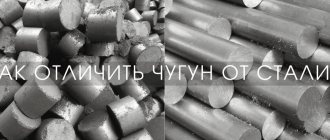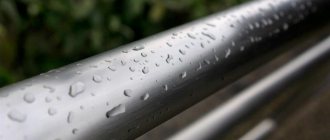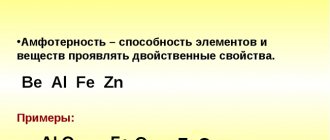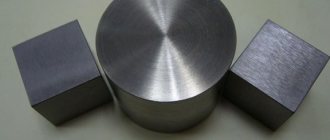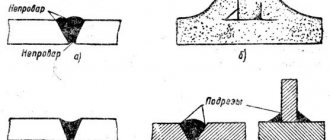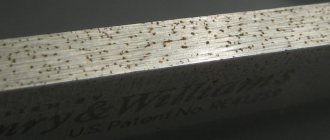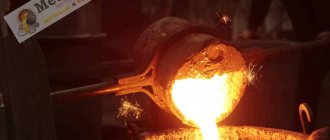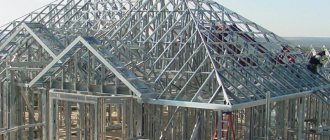Rust color
Rust
- is a general term for iron oxides.
Colloquially, the word applies to the red oxides formed by the reaction of iron with oxygen in the presence of water or moist air. There are other forms of rust, such as a product formed when iron reacts with chlorine in the absence of oxygen. This substance is formed, in particular, in the reinforcement used in underwater concrete pillars, and is called green rust
. Several types of corrosion are distinguishable visually or using spectroscopy, and they form under different environmental conditions. Rust consists of hydrated iron (III) oxide Fe2O3 nH2O and iron metahydroxide (FeO(OH), Fe(OH)3). Given oxygen, water and enough time, any mass of iron will eventually convert completely to rust and break down. A rust surface does not provide protection for the underlying iron, unlike the formation of a patina on a copper surface.
Rust generally refers to the corrosion product of iron and its alloys such as steel. Many other metals also corrode, but it is iron oxides that are commonly referred to as rust.
Chemical basis of the iron corrosion process
Iron is a reactive metal. In the presence of oxygen and water, it undergoes oxidation, forming various compounds: oxides, hydroxides, oxide hydrates. Khimki states that there is no specific formula for rust. What is rust? This is corrosion that is formed due to the oxidation of iron. It has a variable composition that depends on the environment.
Rust affects iron over its entire surface. However, the most vulnerable are the internal and external components of products, welding seams, and threaded connections. The structures of rusty iron are characterized by a significant degree of looseness. Rust does not have any adhesion to metal. Due to the fact that the highly porous corrosion surface freely retains atmospheric moisture, optimal conditions are created for further destruction of iron.
Usually the color of rust is red-brown, brown, which does not allow one to assess the condition of the iron under the layer of corrosion. Under rust, the metal can be completely destroyed. If measures are not taken to prevent its spread, the effects of corrosion on iron can be catastrophic and lead to complete destruction of structures. This is especially dangerous if rust has corroded power line supports or the bottom of a marine vessel. What rust is for a car, and what harm it causes, is known to every motorist.
Economic effect
Rust causes degradation of products and structures made from iron-based materials. Since rust has a much larger volume than the original iron, its buildup leads to rapid destruction of the structure, increasing corrosion in adjacent areas - a phenomenon called rust eating
. This phenomenon caused the destruction of the Mianus River Bridge (Connecticut, USA) in 1983, when the bearings of the lifting mechanism completely rusted from the inside. As a result, this mechanism caught the corner of one of the road slabs and moved it from the supports. Rust was also a major cause of the collapse of the Silver Bridge in West Virginia in 1967, when the steel suspension bridge collapsed in less than a minute. 46 drivers and passengers who were on the bridge at the time were killed.
Kinzu Bridge after destruction.
The Kinzu Bridge in Pennsylvania was torn down by a tornado in 2003, in large part because the central support bolts connecting the structure to the ground had rusted, leaving the bridge supported only by gravity.
In addition, corrosion of concrete-coated steel and iron can cause the concrete to split, creating serious design difficulties. This is one of the most common failures of reinforced concrete bridges.
Causes of rust
Rust begins to appear when metal comes into contact with oxygen, water, oxidizing agents or acids. One of the conditions for metal to rust is the presence of impurities or additives in it. If there is contact of iron with external irritants in the presence of salt (salt water), then corrosion destroys it much faster due to the onset of electrochemical reactions.
If iron is pure, without impurities, then it is much more resistant to the effects of oxygen and water. Just like metals such as aluminum, a dense oxide coating (passivation layer) is formed on its surface, which protects the bulk of the iron from deeper oxidation. However, this layer can also be destroyed if iron begins to interact with oxygen and water together.
Other factors that actively destroy iron are carbon dioxide in water and sulfur dioxide. When exposed to them, various types of iron hydroxide are very actively formed. They, unlike iron oxides, cannot protect the metal. The hydroxide, when formed, begins to peel off from the surface of the iron, after which the lower layer is negatively affected, which also peels off. And this process lasts until all the metal is destroyed, or there is no oxygen, carbon dioxide, sulfur and water left in the environment.
If iron, undergoing combustion in air, comes into contact with oxygen, then the formation of iron oxide ii occurs.
When burned in pure oxygen - oxide IV.
Iron III oxide is formed when air or oxygen passes through a metal in a molten state.
Rust Prevention
Peeling paint exposes areas of rusty sheet metal surface.
Rust is permeable to air and water, so the underlying iron continues to corrode. Preventing rust therefore requires a coating that prevents rust from forming. A passivating layer of chromium (III) oxide forms on the surface of stainless steel. A similar manifestation of passivation occurs with magnesium, titanium, zinc, zinc oxide, aluminum, polyaniline and other electrically conductive polymers.
Galvanization
A good approach to preventing rust is the galvanization method, which typically involves applying a layer of zinc to the object to be protected, either by hot-dip galvanizing or electroplating. Zinc is traditionally used because it is inexpensive, has good adhesion to steel, and provides cathodic protection to the steel surface if the zinc layer is damaged. In more aggressive environments (such as salt water), cadmium is preferred. Galvanization often does not reach the seams, holes and joints through which the coating was applied. In these cases, the coating provides cathodic protection to the metal, where it acts as a galvanic anode, which is primarily affected by corrosion. Aluminum is added to more modern coatings; the new material is called zinc-aluminum
. The aluminum in the coating migrates, covering scratches and thus providing longer lasting protection. This method relies on the use of aluminum and zinc oxides to protect surface scratches, as opposed to an oxidation process such as a galvanic anode. In some cases, in very aggressive environments or long service life, both zinc galvanization and other protective coatings are used simultaneously to provide reliable protection against corrosion.
Cathodic protection
Cathodic protection is a method used to prevent corrosion in structures hidden underground or underwater by introducing an electrical charge that inhibits electrochemical reactions. If used correctly, corrosion can be stopped completely. In its simplest form, this is achieved by connecting the object to be protected to a sacrificial anode, resulting in only a cathodic process occurring on the surface of the iron or steel. The sacrificial anode must be made of a metal with a more negative electrode potential than iron or steel, usually zinc, aluminum or magnesium.
Paintwork and other protective coatings
Rust can be prevented by using paint and other protective coatings that isolate the iron from the environment. Large surfaces divided into sections, such as the hulls of ships and modern cars, are often coated with wax-based products. Such treatments also contain corrosion inhibitors. Coating steel reinforcement with concrete (reinforced concrete) provides some protection for steel in high pH environments. However, corrosion of steel in concrete is still a problem.
Metal coating
Rust can completely destroy iron. Pay attention to the galvanization of non-rusted areas.
- Galvanizing (Galvanized Iron/Steel): Iron or steel is coated with a layer of zinc. The hot-dip galvanizing method or the zinc blowing method can be used.
- Tinning: Mild steel sheet is coated with a layer of tin. Currently, it is practically not used due to the high cost of tin.
- Chrome Plating: A thin layer of chrome is electrolytically applied to steel, providing both corrosion protection and a bright, polished appearance. Often used in shiny components of bicycles, motorcycles and automobiles.
Blueing
Blueing is a method that can provide limited corrosion resistance to small steel objects, such as firearms, etc. The method consists of obtaining a layer of iron oxides 1-10 microns thick on the surface of carbon or low-alloy steel or cast iron. To add shine, as well as to improve the protective properties of the oxide film, it is impregnated with mineral or vegetable oil.
Humidity reduction
Rust can be avoided by reducing the humidity in the air surrounding the iron. This can be achieved, for example, using silica gel.
Inhibitors
Corrosion inhibitors, such as gaseous or volatile inhibitors, can be used to prevent corrosion in closed systems. Some corrosion inhibitors are extremely toxic. One of the best inhibitors are salts of technicic acid.
Rust composition
Rust, which forms under normal conditions, is usually a mixture of 3 iron oxides. They are not formed at one moment and have different physical and mechanical properties. Iron oxides from the lowest layer towards the surface are a combination of the following components:
- Wustite (iron oxide) is a soft structure, depending on the conditions in which the metal is located. If the storage temperature is high, then this layer is the largest.
- magnetite (magnetic iron ore) is an iron oxide with higher porosity than the vustid layer and lower hardness. This structure has pronounced magnetic properties.
- Hematite (red iron ore) is usually a red-gray structure, a hard abrasive substance. Hematite has a higher density, corrodes metal and increases the coefficient of friction when in contact with surfaces.
Before starting work to eliminate rust, it is necessary to know the composition of the metal, especially on its surface, and also to establish the conditions that contributed to its appearance. With this information, it’s easy to find the best option for removing iron oxide and choose the most effective rust control products.
Organosilicate coatings
For high-quality protection against corrosion, it is recommended to use metals with a high level of hydrophobicity and impermeability in water, gas and steam environments. These materials include organosilicates.
Chemical corrosion practically does not apply to organosilicate materials. The reasons for this lie in the increased chemical stability of such compositions, their resistance to light, hydrophobic properties and low water absorption. Organosilicates are also resistant to low temperatures, have good adhesive properties and wear resistance.
The problems of metal destruction due to corrosion do not disappear, despite the development of technologies to combat them. The reason is the constant increase in metal production volumes and increasingly difficult operating conditions for products made from them. It is impossible to completely solve the problem at this stage, so the efforts of scientists are focused on finding ways to slow down corrosion processes.
Classification of methods to combat corrosion
Taking into account the main components of corrosion, methods for removing rust are divided into the following:
- Mechanical - the elimination of the oxide layer is carried out using hard metal brushes, sandpaper, etc.
- Thermal - carried out by exposing corrosion to high temperatures, usually in combination with water and (or) air flows.
- chemical - removal of iron oxides is carried out as a result of exposure to special agents that dissolve rust when applied to the metal surface.
It must be taken into account that the effectiveness of the above methods varies. So, if the process of corrosion formation is established in a timely manner, and this is a small spot, then the surface of the iron can be effectively treated with a steel brush, coarse-grained sandpaper, or an angle grinder with an appropriate attachment.
However, if it is determined that rust has affected large surfaces, then chemical methods will be the best.
If the areas of rusty metal are very large and cannot be transported, then heat treatment is considered optimal, but it is associated with high labor intensity.
Typically, metal processing to remove rust is carried out using combined methods, in which various methods are used in a certain sequence.
Mechanical methods
The choice of a specific machining method depends on the type of iron surface. So, for coils of steel wire, it is used to rewind it from one carrier to another. In this case, when kinked, the rust is separated from the metal surface.
When removing corrosion mechanically, stiff steel bristle brushes or sandpaper (coarse-grained) are usually used.
The disadvantages of mechanical methods of getting rid of rust include the fact that marks left by the cleaning tool remain on the surface of the iron. Therefore, it is recommended that the surface of purified iron be polished to give it its previous appearance.
Thermal cleaning
To remove rust using thermal methods, special installations are required (industrial steam generators or construction hair dryers). The method of cleaning from iron oxides is based on the fact that the contact of rust with the base metal is not strong. The impact of elevated temperature and hot moisture with high-speed air flow is such that rust is removed almost completely.
This method is most effective when hot steam is also supplied to the surface being treated. The steam-air mixture in the jet, which is supplied to the metal surface under pressure, leads to softening of the rust, crushing it into separate fragments, which are removed from the surface of the iron by an air flow.
These methods are especially effective when it is necessary to remove rust from steel doors, ventilation structures, and metal structures that are impossible or difficult to dismantle.
Chemical cleaning
Currently, methods for chemically cleaning metal surfaces from rust are very diverse. However, they are all based on the same process - removing corrosion through chemical action on it with acid solutions.
The most effective ways to get rid of iron oxides include treating rust with hydrochloric acid, especially when its concentration in the solution is at least 15%. If the concentration is lower, then the dissolution of rust is significantly slower.
Acidic compounds based on sulfuric acid should not be used, since as a result of exposure, a layer of hydrides is formed on the surface of the iron, which increases the fragility of the metal.
If it is necessary to chemically clean metal at home, then it is possible to use non-aggressive substances such as lemon, vinegar, etc. The principle of influencing corrosion is the same. These substances dissolve rust quite well, which can then be easily removed with a rag. Most housewives probably know what rust is and how to remove it.
Corrosion in non-electrolyte liquids
Non-conducting liquid media (i.e. non-electrolyte liquids) include organic substances such as:
- benzene;
- chloroform;
- alcohols;
- carbon tetrachloride;
- phenol;
- oil;
- petrol;
- kerosene, etc.
In addition, small amounts of inorganic liquids, such as liquid bromine and molten sulfur, are considered non-electrolyte liquids.
It should be noted that organic solvents themselves do not react with metals, however, in the presence of a small volume of impurities, an intensive interaction process occurs.
Sulfur-containing elements in oil increase the corrosion rate. Also, high temperatures and the presence of oxygen in the liquid intensify corrosion processes. Moisture intensifies the development of corrosion in accordance with the electromechanical principle.
Another factor in the rapid development of corrosion is liquid bromine. At normal temperatures it is especially destructive to high-carbon steels, aluminum and titanium. The effect of bromine on iron and nickel is less significant. Lead, silver, tantalum and platinum show the greatest resistance to liquid bromine.
Molten sulfur reacts aggressively with almost all metals, primarily with lead, tin and copper. Sulfur has less effect on carbon steels and titanium and almost completely destroys aluminum.
Protective measures for metal structures located in non-electrically conductive liquid environments are carried out by adding metals that are resistant to a specific environment (for example, steels with a high chromium content). Also, special protective coatings are used (for example, in environments where there is a lot of sulfur, aluminum coatings are used).
Use of other equipment to remove metal corrosion
Mechanical methods of combating rust are not always possible, especially if metal products have complex shapes.
Chemical methods also have certain disadvantages. If you do not follow safety precautions, you can get a chemical burn or poisoning. There are difficulties with the disposal of waste solutions.
As a result, the most optimal method is to use the so-called soft blasting method. Its principle is that a stream of compressed air, which contains abrasive components, is directed onto the surface of a metal damaged by rust.
By changing the pressure in the jet, you can adjust the depth of the layer that is removed. This results in only the rust being removed, while the metal itself remains intact. Granules that act on corrosion consist of finely dispersed soda and chalk; very fine sand can also be used.
